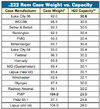rdnktrkr
Member
I also separate and weigh brass for any accurate loads, for 55 or 62gr blaster ammo I don't think it matters, The press mounted RCBS primer pocket swager for crimped brass works better than the screwdriver bit or the bevel bit. I picked up some Perfecto(sp) brass once that had very offset flash holes and broke a couple of pins while decapping. I bought a few cases of IMI ammo a few years back and have had no issues with their brass and use it with my 69gr accurate reloads.


